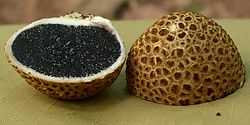Gleba

Gleba is the fleshy spore-bearing inner mass of fungi such as the puffball or stinkhorn.
The gleba is a solid mass of spores, generated within an enclosed area within the sporocarp. The continuous maturity of the sporogenous cells leave the spores behind as a powdery mass that can be easily blown away. The gleba may be sticky or it may be enclosed in a case (peridiole).[1]
It is a tissue usually found in an angiocarpous fruit-body, especially gasteromycetes. Angiocarpous fruit-bodies usually consist of fruit enclosed within a covering that does not form a part of itself; such as the filbert covered by its husk, or the acorn seated in its cupule. The presence of gleba can be found in earthballs and puffballs. The gleba consists of mycelium, and basidia and may also contain capillitium threads.[2]
Gleba found on the fruit body of species in the family Phallaceae is typically gelatinous, often foetid-smelling, and deliquescent (becoming liquid from the absorption of water). It is formed on the exterior face of the cap or the upper part of the fruit body. The foul smell helps to attract insects that help disperse the spores. Chemicals that contribute to the odor include methylmercaptan and hydrogen sulfide.[3]
In Popular Culture
In the episode of Friends "The One with the Lottery" Emma says her first word, gleba, on the phone with her mother Rachel Green. Ross Geller didn’t think it counts because he thought it’s not a real word. Rachel looks it up and proves him wrong.
References
| Wikimedia Commons has media related to Gleba. |
- ↑ "gleba definition". Mycological Glossary. Illinois, United States: Illinois Mycological Association. Retrieved 2008-10-24.
As the spores mature, the sporogenous cells often liquify and/or disintegrate, leaving just the spores behind as a powdery mass that can easily blow away... In other cases, the gleba may be sticky, as in Sphaerobolus stellatus; or it may be enclosed in a case (called a peridiole), as in the Nidulariaceae.
- ↑ Miller HR, Miller OK. (1988). Gasteromycetes: Morphological and Developmental Features, with Keys to the Orders, Families, and Genera. Eureka, California: Mad River Press. ISBN 0-916422-74-7.
- ↑ Miller and Miller (1988), p. 75.